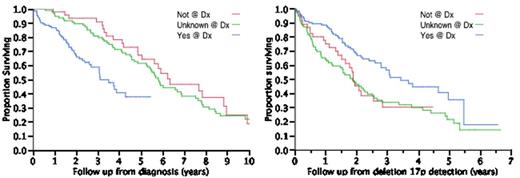Abstract
Patients with Multiple myeloma (MM) with a 17p deletion (del17p) have a poor outcome, often presenting with aggressive disease and short response duration with current therapies. We studied the clinical features of patients with del17p, either at diagnosis or at relapse, treatment responses and potential risk factors for acquisition of this abnormality.
We reviewed all plasma cell FISH tests performed in patients with MM during 2004-2011, in order to identify patients with a del17p/ monosomy 17. If the abnormality was identified on FISH testing at any time before the diagnosis of MM or within 3 months of diagnosis, the patient was considered to have a del17p at diagnosis. For patients with del17p identified beyond three months, we identified 1-2 controls for each patient, who had FISH performed at the same duration after diagnosis but did not have a del17p/ monosomy 17.
We identified 264 patients with MM, who had a del17p detected by FISH at some time during the disease course. The median age at MM diagnosis was 61.5 years and 60% were male. The median follow up from diagnosis was 5.4 years with 124 (47%) alive at last follow up. One hundred twenty three had del17p at diagnosis, 95 had unknown 17p status at diagnosis, and 46 had a FISH with no del17p at diagnosis. The median overall survival from diagnosis for the entire cohort was 5.5 years; for the three groups median survival was 3.1, 5.8 and 6.3 years respectively (P<0.01) (Figure 1). Similarly, the OS from the time of detection of del17p for the three groups respectively were 3.4, 1.9 and 1.9 years, respectively (P<0.01) (Figure 2). In the group of patients with del17p observed beyond three months from diagnosis, the median time to detection of the abnormality was 42 (3-166) months.
Given the similar outcomes, the latter two groups were considered together as acquired del17p (n=141). This group of patients was then compared to a control population of 271 patients. The median OS from diagnosis and from the date of the FISH testing for the acquired del17p patients was 5.8 and 1.9 years respectively, compared with 7.5 and 2.8 years respectively for the control patients (P<0.01 for both). We then compared the cases and controls to identify factors at diagnosis associated with a risk of acquiring a del17p and found presence of monosomy 13 by FISH, presence of high risk translocations (t(14;16) t(14;20)), BMPC >=50%, or PCLI >= 3% at baseline predicted for increased risk of acquiring del17p. There was no relationship between use of novel agents in the first line of therapy or use of SCT as part of initial therapy and the development of del17p. Overall, 75% of patients with an acquired del17p had one of the three features, compared with 47% of patients who did not acquire a del17p. Finally, we also examined the impact of the proportion of cells with del17p. The median proportion of PCs with 17p deletion was 86% (range 9-100%). Patients with >80% cells with del17p had an inferior survival compared to the rest (1.9 vs. 2.8 years, p=0.01).
The presence of del17p at diagnosis or acquisition anytime during the disease course is associated with poor overall survival. Patients with high-risk features at diagnosis such as high-risk translocations and highly proliferative disease have a higher risk of developing del17p during the course of disease, which may in part explain the poor prognosis seen in patients with these high-risk features. The proportion of PCs with del 17p appears to impact the prognostic value of this abnormality.
Kumar:Celgene: Consultancy, Research Funding; Millennium: Consultancy, Research Funding; Onyx: Consultancy, Research Funding.
Author notes
Asterisk with author names denotes non-ASH members.


This feature is available to Subscribers Only
Sign In or Create an Account Close Modal